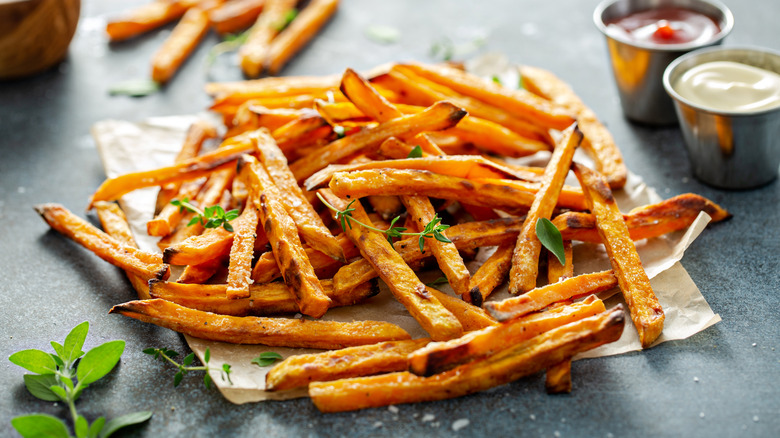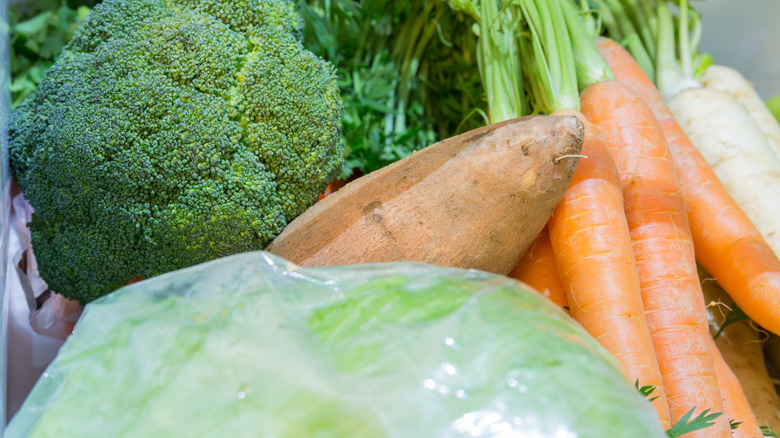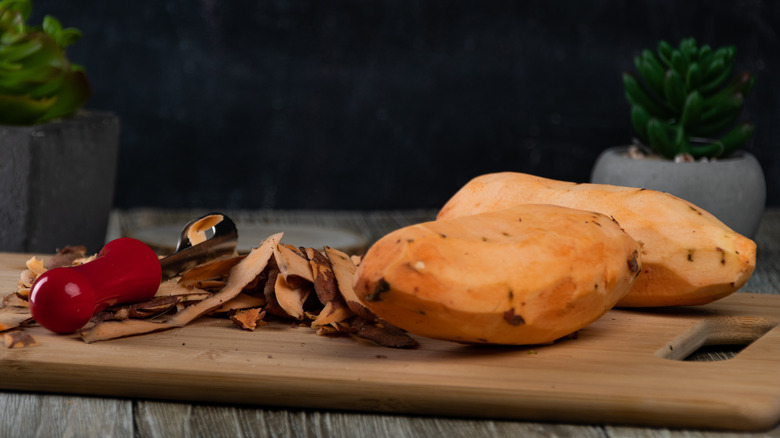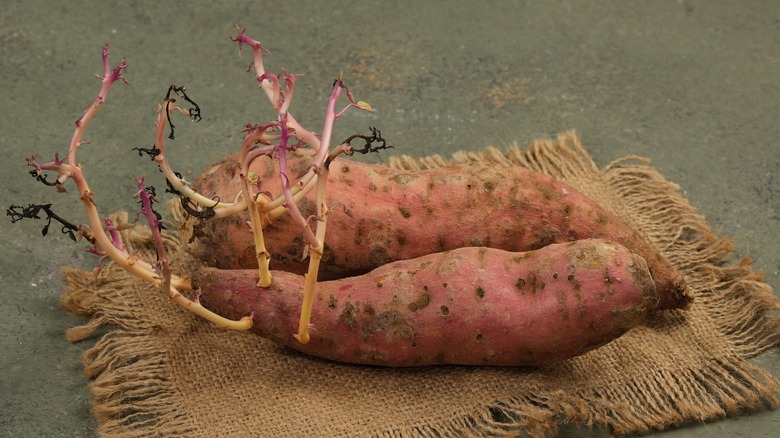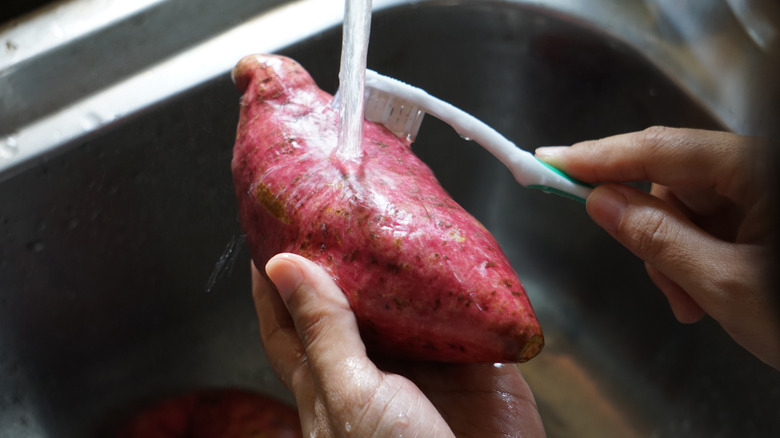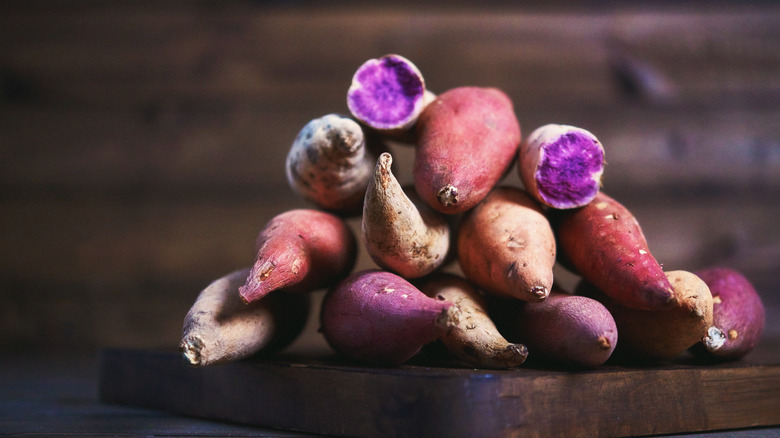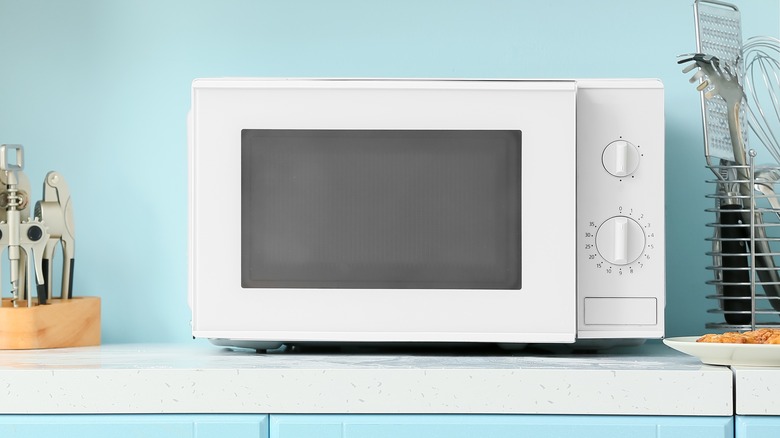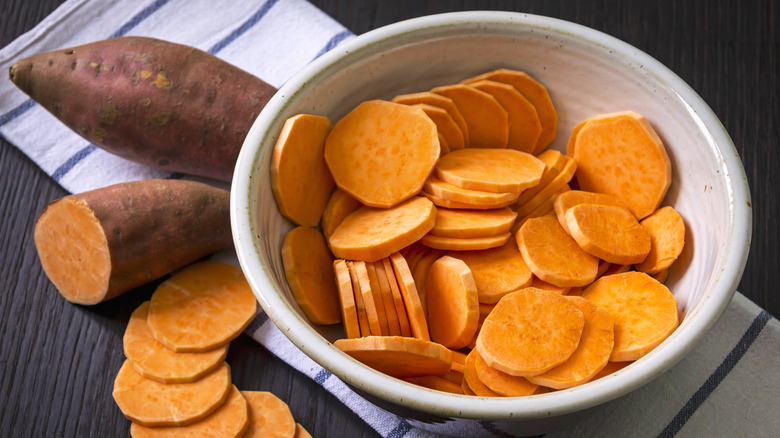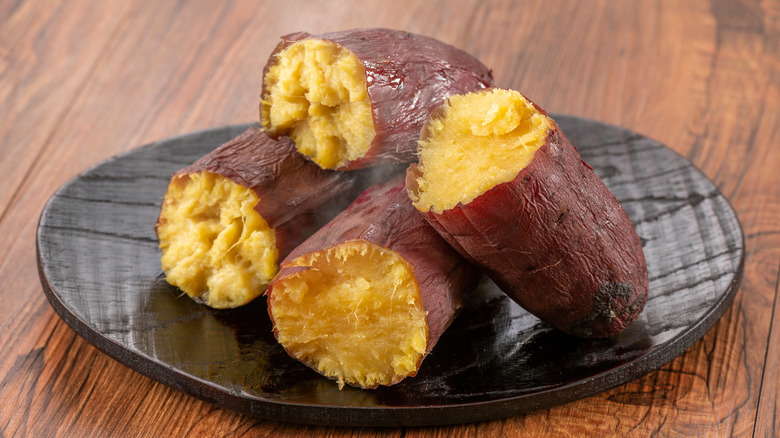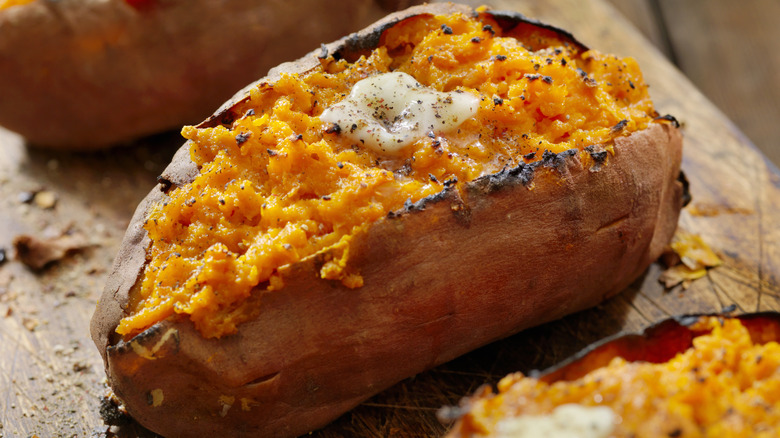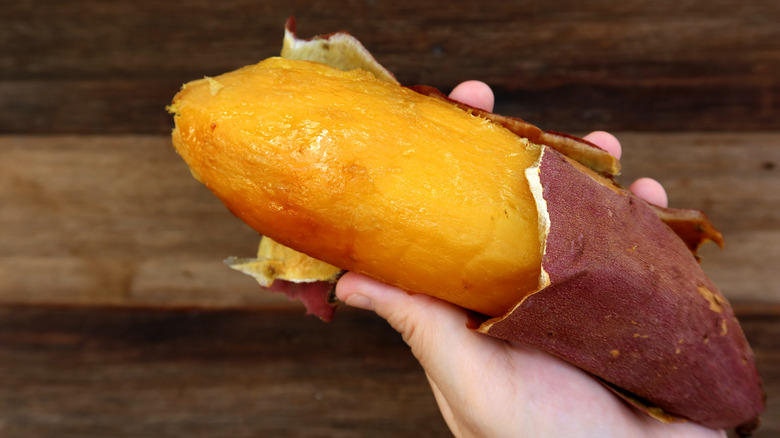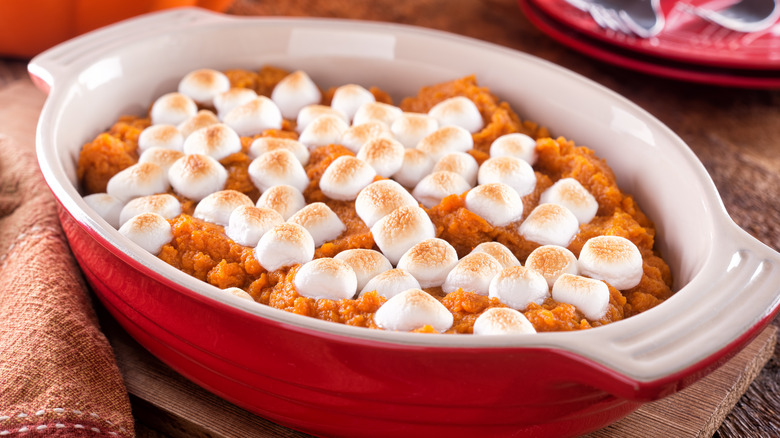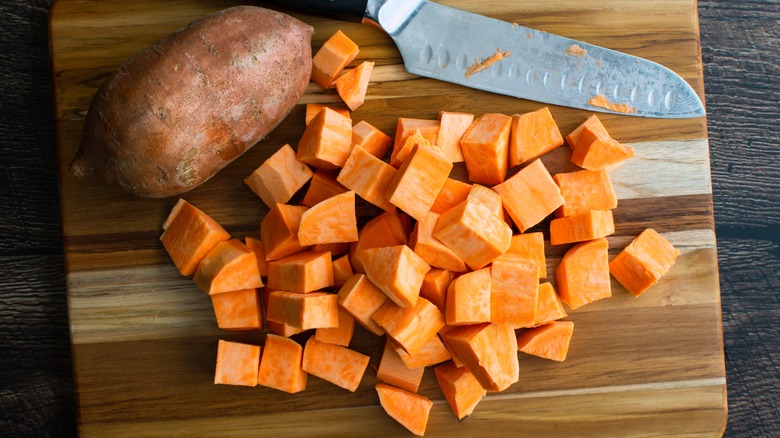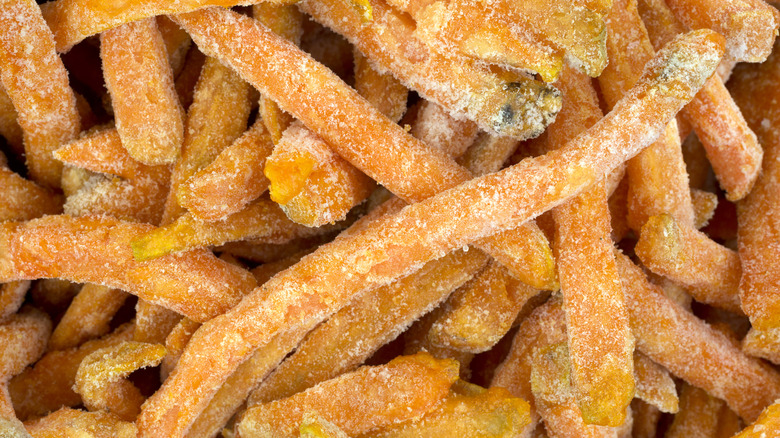14 Common Mistakes People Make With Sweet Potatoes
Sweet potatoes have been around for longer than you might think. While the origins of the sweet potato are hotly debated, the plant's history may stretch back as far as 57 million years, with the very earliest forms of the family it comes from, the morning glory, being found in fossilized remains in India. Sweet potatoes as a food may have come quite long after that, with the first cultivation potentially happening around 2500-1850 B.C., and they seem to have been crossing the Pacific Ocean way back in A.D. 1100 when the plant appears to have traveled from South America to Polynesia. All of this, of course, points towards sweet potatoes being as popular back in the day as they are now, whether they're baked into a casserole or cooked as fries.
So, if sweet potatoes have been cooked by humans for thousands of years, why do we still get them so wrong? You'd think by now we'd have nailed it, but these tubers can be surprisingly tricky to get right. Sweet potatoes have a tendency to become too soft way too quickly or else remain hard and challenging to eat. And while storing them may seem simple, it's all too easy to mess it up and end up with a browning or brittle potato. The key, though, is to avoid these common mistakes for great sweet potatoes every time.
Placing them in the refrigerator
Many vegetables are better off in the refrigerator, but when it comes to tubers like potatoes and sweet potatoes, they're happier at room temperature. Putting sweet potatoes in the fridge can significantly alter their texture and flavor, leaving them with "a hard center and unpleasant taste," according to the University of Rhode Island's research associate and food safety specialist Nicole Richard, per Martha Stewart. When the potatoes are plunged to a low temperature, their structure starts to change, both altering their flavor and making them tough.
Instead, you should keep your sweet potatoes in a cool, dark area, like a drawer or store cupboard. It's essential that the sweet potatoes have enough ventilation around them, too. If kept at the right temperature (between 55 to 60 degrees Fahrenheit is ideal), sweet potatoes should last for up to six months.
Cooked sweet potatoes, however, are another matter. If you've cooked your potatoes, they should be refrigerated once cool, as leaving them at room temperature leaves them more vulnerable to bacteria growing on them. You should never keep cooked sweet potatoes in the fridge for longer than a week, although they may go bad sooner than that.
Throwing away their skins
We can understand why you might want to get rid of your sweet potato skins: After all, they ruin the vibrant orange of the vegetable and don't exactly have the sweet, delicious taste that the flesh does. But throwing them away means that you miss out on a huge amount of nutritional goodness. Sweet potato skins hold the majority of the vegetable's fiber and have a healthy stock of necessary vitamins and minerals like potassium, vitamin C, and manganese. This fiber content, in particular, is what makes unpeeled sweet potatoes so filling.
While you'll still get good nutritional value if you peel them, you won't get as much. Remember, sweet potato skins are fully edible and have a nutty, grassy flavor all of their own, which can make your sweet potato fries way more interesting. If you would prefer to peel your sweet potatoes for aesthetic or flavor reasons, though, try and use them in a different way. You could, for example, make sweet potato skin chips by tossing the peels in some oil, salt, and spices and cooking them in an oven until they're browned and crispy.
Using sweet potatoes that have gone bad
If you don't cook sweet potatoes often, it can be challenging to know when they've gone bad — the best thing to do is to rely on your senses. Your first clue is if your sweet potato has started to change color or texture. As sweet potatoes get older, they lose moisture, and this can make the outside of them appear wrinkly or shriveled. Old sweet potatoes may also have discoloration when you slice into them, with the orange flesh turning brown or black, and they can also sprout shoots.
Sweet potatoes that have gone bad may also appear moldy, slimy, too soft, or start to smell strange. If the spoilage on your sweet potato is just in one spot and the rest of it seems okay, you might be able to cut it off and use the parts that are still fresh. If it all seems off, though, you should throw it out. Eating a spoiled sweet potato may not give you food poisoning, as the type of bacteria that cause illness is different from that which causes spoilage. However, you can't be sure that your stomach won't dislike it. Aside from that, it'll taste terrible.
Forgetting to wash them
Even if your sweet potato looks clean, it's still important to wash it. Sweet potatoes, like all vegetables and fruits, can be a vehicle for food poisoning, even in fresh-looking produce. "The right thing to do is to wash your fruits and veg because there can be lots of nasty, harmful pathogens on there, bacteria that can be harmful," says food scientist Stuart Farrimond, per BBC Scotland. "You don't know who's been handling it, you don't know what bacteria and what germs have been in the soil and even whether it's been washed before it gets to the supermarket."
As sweet potatoes are tuberous roots, they grow in the ground, which also makes them more prone to carrying specks of dirt and soil, which can be unpleasant to eat. The bumpy, irregular shape of the vegetable can mean that soil is more likely to collect in its nooks and crannies. For this reason, vigorously cleaning them is crucial. Use a firm-bristled brush or a toothbrush and scrub the sweet potato thoroughly under a running tap. There's no need to use soaps or fancy cleaning products to clean them — using those could even make things worse and introduce harsh chemicals onto the surface of your food.
Using different sweet potatoes in the same way
Like regular potatoes, sweet potatoes come in a range of shapes, sizes, and shades. As well as varying by visual appearance, they can also vary significantly in terms of taste — meaning that mixing and matching different sweet potatoes for different uses can result in your meal tasting a little weird.
Most sweet potatoes are from the Beauregard cultivar, and this red-skinned, orange-fleshed variety is pretty versatile and excellent whether it's baked, fried, or mashed. Others, like the Hannah cultivar, have lighter skin, drier flesh, and a sweeter flavor, making them more suitable for use in sweet dishes and potentially less useful for making fries or wedges. The O'Henry variety is similarly pale but with denser flesh, potentially making it better suited for being baked or mashed.
Purple sweet potatoes are even more different, both in terms of color and flavor. These varieties have bright-purple flesh and a slightly more acidic or nutty flavor, depending on the type you get. This generally means that they're better in dishes where the sweet potato is the star of the show and can shine on its own. Try making some roast sweet potato wedges with these and lightly seasoning them with some Tex-Mex flavors.
Microwaving them whole
The microwave can cut the cooking time of items down considerably, and it's a godsend for regular potatoes. Instead of waiting up to an hour for your potato to bake, you can just prick it with a fork, stick it in the microwave for five minutes, and you're ready to go.
With sweet potatoes, however, it's another story. Whole sweet potatoes are way more irregularly shaped than commercially available potatoes and tend to develop odd little corners and rivets. This means that microwaving it will result in it being unevenly cooked, with some parts done before others. Sweet potatoes are also pretty dense, and it can take a while for the energy from the microwave to permeate all the way through to the center. As a result, your sweet potato can be done on the outside and still be raw on the inside.
If you do decide to microwave your sweet potatoes, rest assured that they'll remain as nutritious as if you cooked them another way. The idea that microwaving food kills nutrients is somewhat of a myth. Nuking your grub in your microwave oven can actually allow it to retain nutrients better, as it cuts down on cooking time and, therefore, reduces exposure to constant heat, which can cause nutrient degradation.
Storing sliced sweet potatoes incorrectly
Some vegetables fare pretty well once they've been sliced, but sweet potatoes can be somewhat temperamental. Once you slice into them and expose the orange flesh inside, the starches in them start to oxidize. This can quickly turn your vibrant, luminous sweet potato into a shade of dark brown and make it look very unappealing.
It's the same process that turns apples and bananas brown when you slice them, and while it doesn't necessarily make them unsafe to eat, it's not exactly nice to look at. With sweet potatoes, oxidation can happen within half an hour, so you need to act fast. Rather than leave your sweet potatoes out in the open and watch them brown, place your sliced pieces in a bowl of cold water, making sure they're fully covered. The water acts as a barrier between the sweet potatoes and the air and will keep them looking fresh.
As an added bonus, keeping sliced sweet potatoes covered in cold water will also stop them from drying out once sliced. Remember, though, that you should use sliced sweet potatoes within a few days for the freshest result. Remember to pat them dry before cooking them, too, so that they don't steam from any leftover moisture.
Thinking they're significantly healthier than other potatoes
Sweet potatoes are full of goodness. They're an abundant source of vitamin C and vitamin A and are also a good source of minerals like copper, manganese, and potassium. But it's a mistake to think that they're way more nutritious than regular potatoes.
The fact is that both potatoes and sweet potatoes are nutritious, and when placed side-by-side, there aren't a vast number of differences between them. Both types of potato are a good source of fiber (although sweet potatoes do have slightly more), have the same amount of protein and fat in them, and contain vitamins B6 and C, as well as magnesium. Regular potatoes also have more potassium in them than sweet potatoes.
Where sweet potatoes do have the edge, however, is with their vitamin A content. Regular potatoes have approximately 0.1% of your daily value per 100 grams, whereas sweet potatoes will provide the total amount you need in a day, plus a little extra. According to the Mayo Clinic, this vitamin is vital to maintaining good vision and reproductive health — having a regular dietary source like sweet potatoes is very important.
Pricking your sweet potatoes before baking
How many times have you been told to prick a potato before baking it? If you don't follow that advice, you really should. Pricking potatoes before baking or microwaving them allows the steam that builds up inside the flesh while cooking to escape, preventing them from exploding in the middle of your oven.
With sweet potatoes, however, it's another story. Instead of allowing the steam to escape, keep it sealed in the potato as much as possible to ensure the flesh becomes fluffy and retains its sugar content. This means that if you're baking it, you should leave it unpierced. Don't worry — the potato won't burst and will instead steam to perfection on the inside, leaving the skin easy to strip off.
Crucially, though, microwaving sweet potatoes is a different story. If you're microwaving them, the steam will build up at a much quicker speed, and the skin won't be able to handle it, resulting in an explosion. As such, make sure you're pricking them a few times if you're nuking them.
Peeling them when raw
If you've ever tried to peel a sweet potato raw, you'll know how tricky it is. Uncooked sweet potatoes are tough and tend not to yield their skin willingly, and unless you have a super-sharp peeler, it can be tricky to remove it with ease. This is all made even harder by the shape of sweet potatoes, which can be unpredictable and irregular — and if you have a particularly knobbly one, peeling it can be near impossible.
The key is to wait until your sweet potato is cooked to peel it. Bake your sweet potatoes before slicing off each end and stripping the skin off. As the potato cooks, the steam from the inside will soften and loosen the skin, making it a cinch to peel off easily. This method will also take minimal sweet potato flesh with it, whereas peeling them raw can sometimes result in you removing half of the vegetable while doing so.
If you're making fries or another item where removing the skin is necessary before cooking them, though, this can be tricky to do. The best solution is to try and find as smooth a sweet potato as possible to make peeling it easier.
Forgetting the versatility of your sweet potatoes
One of the biggest mistakes you can make with your sweet potatoes is cooking them the same way every time. Sweet potatoes are one of those ingredients, like rice, peanut butter, and lemons that lend themselves as well to being included in sweet foods as in savory ones. The clue with the former is in the sweet potato's name. The reason sweet potatoes are so uniquely sugary is that when they're cooked, their starch turns into maltose, a mild form of sugar that's also present in peaches and pears and is used in breakfast cereals.
Despite containing maltose, though, sweet potatoes tend to be used more commonly in savory ways. But we recommend really leaning into their sweetness. One of the best examples of this, of course, is sweet potato casserole, the Thanksgiving staple that combines sugar, butter, eggs, pecans, and marshmallows with the root vegetable. But some of your favorite sweet foods, like ice cream, can also be made using sweet potatoes, giving the dessert a slightly nutty flavor and bright orange tones. Cooked sweet potato can also be mixed in pancake or waffle batter, again giving it both color and flavor.
Boiling your sweet potatoes
Boiling food can be one of the quickest and easiest ways to cook it, and to do so, you only need some water, a pot, some heat, and a little patience. But we would seriously recommend keeping sweet potatoes away from a boiling pan. Boiling sweet potatoes is a surefire way to make them waterlogged, soggy, and unappealing. When you boil these tubers, it completely ruins their texture, removing any of the fluffiness that's caused by a build-up of steam and turning them to mush.
Boiling sweet potatoes is not the best culinary choice from a taste perspective. Although boiling softens sweet potatoes, it doesn't do much to improve their flavor. "Roasting sweet potatoes in the oven whole or cut into cubes [caramelizes] the starchy flesh of the potatoes, making them sweeter and giving them a velvety texture," Neha Pathania, chief dietician at Paras Hospitals, explained to Healthshots.
Pathania does note, however, that boiling sweet potatoes does produce a better GI number for the vegetable than roasting them, meaning that they're less likely to cause a spike in blood sugar. Boiling them also allows you to cook them without using any fat, which could be a consideration for people following low-fat diets.
Freezing your sweet potatoes without cooking them first
Like most vegetables, sweet potatoes can be frozen, and doing so is a great way to extend their lifespan. In the freezer, they can last for up to a year, provided that they're stored and prepared correctly. Unfortunately, though, it's not as simple as just slicing them raw and putting them in the freezer. If you do so, the active enzymes that live in the vegetable, which help us digest it once eaten, will continue to work, breaking it down and ruining its flavor and texture. Their high water content can also be an issue, as this can result in freezer burn as the moisture works its way to the surface and evaporates into the freezer air.
To counteract this, you have to cook your sweet potatoes before freezing them. Once they're cooked, ensure that they're fully dry and cool so you're not freezing them with any excess moisture. Seal them in an airtight container or Ziploc bag, squeezing any air out of them before placing them in the freezer. Avoid placing anything on top of them, as sweet potatoes get soft when cooked, and this can ruin their shape.
